Roots, Tissues, Cells and Fragments—How to Characterize Peat from Drained and Rewetted Fens
Abstract
1. Introduction
2. Material and Methods
2.1. Analysis of Macro-Remains
2.2. Analysis of Micro-Remains
2.3. Diagrams
3. Results
3.1. Description of Macro- and Micro-Remain Morphotypes
3.1.1. Radicel Types
3.1.2. Microscopic Morphotypes
3.2. Diagrams
3.3. Dating
4. Discussion
4.1. Site Development
4.2. Morphotypes
5. Conclusions
Author Contributions
Founding
Acknowledgments
Conflicts of Interest
References
- Loisel, J.; van Bellen, S.; Pelletier, L.; Talbot, J.; Hugelius, G.; Karran, D.; Yu, Z.; Nichols, J.; Holmquist, J. Insights and issues with estimating northern peatland carbon stocks and fluxes since the Last Glacial Maximum. Earth Sci. Rev. 2017, 165, 59–80. [Google Scholar] [CrossRef]
- Moen, A.; Joosten, H.; Tanneberger, F. Mire diversity in Europe: Mire regionality. In Mires and peatlamds of Europe; Joosten, H., Tanneberger, F., Moen, A., Eds.; Schweizerbart: Stuttgart, Germany, 2017; pp. 97–149. [Google Scholar]
- Weber, C.A. Grenzhorizont und älterer Sphagnumtorf. Abhandl. Naturwissen. Ver. Bremen 1930, 28, 57–65. [Google Scholar]
- Grosse-Brauckmann, G. Analysis of vegetative plant macrofossils. In Handbook of Holocene Palaeoecology and Palaeohydrology; Berglund, B.E., Ed.; John Wiley & Sons: Chichester, UK, 1986; pp. 591–618. [Google Scholar]
- Pegman, A.P.M.; Ogden, J. Productivity-decomposition dynamics of Typha orientalis at Kaitoke Swamp, Great Barrier Island, New Zealand. N. Z. J. Bot. 2005, 43, 779–789. [Google Scholar] [CrossRef]
- Grosse-Brauckmann, G. Über pflanzliche Makrofossilien mitteleuropäischer Torfe. I. Gewebereste krautiger Pflanzen und ihre Bestimmung. Telma 1972, 2, 19–56. [Google Scholar]
- Ronkainen, T.; McClymont, E.L.; Tuittila, E.-S.; Väliranta, M. Plant macrofossil and biomarker evidence of fen–bog transition and associated changes in vegetation in two Finnish peatlands. Holocene 2014, 24, 828–841. [Google Scholar] [CrossRef]
- Van der Linden, M.; Kooistra, L.I.; Engels, S. Non-pollen palynomorphs as relevant indicators in palaeoecology and archaeobotany. Rev. Palaeobot. Palynol. 2012, 186, 1–162. [Google Scholar] [CrossRef]
- Von Post, L.; Granlund, E. Södra Sveriges Torvtillgångar. Sveriges Geol. Unders. Årsbok 1926, 19, 1–127. [Google Scholar]
- Von Bülow, K. 1929: Allgemeine Moorgeologie. Einführung in das Gesamtgebiet der Moorkunde; Borntraeger: Berlin, Germany, 1929; p. 308. [Google Scholar]
- Matjuschenko, W. Schlüssel zur Bestimmung der in den Mooren vorkommenden Carexarten (translation by S. Ruoff). Geol. Archiv. Z. Gesamtgeb. Geol. 1924, 3, 183–188, 192–193. [Google Scholar]
- Bertsch, K. Lehrbuch der Pollenanalyse; Ferdinand Enke: Stuttgart, Germany, 1942; p. 195. [Google Scholar]
- Mauquoy, D.; van Geel, B. Mire and peat macros. In Encyclopedia of Quaternary Science; Elias, S.A., Ed.; Elsevier: Amsterdam, The Netherlands, 2007; Volume 3, pp. 2315–2336. [Google Scholar]
- Drzymulska, D.; Kłosowski, S.; Pawlikowski, P.; Zieliński, P.; Jabłońska, E. The historical development of vegetation of foreshore mires beside humic lakes: Different successional pathways under various environmental conditions. Hydrobiologia 2013, 703, 15–31. [Google Scholar] [CrossRef]
- Nilsson, T. Kvartärpaleontologi och Kvartärpaleontologiska undersökningsmetoder, 4th ed.; Lunds Universitet: Lund, Sweden, 1972; Volume 2, p. 238, Plates 63. [Google Scholar]
- Katz, N.J.; Katz, S.W.; Skobejewa, E.I. Atlas Rastitelnich Ostakow W Torfach. Nedra: Moscow, USSR, 1977; p. 371. [Google Scholar]
- Hughes, P.D.M.; Mauquoy, D.; Barber, K.E.; Langdon, P.G. Mire-development pathways and palaeoclimatic records from a full Holocene peat archive at Walton Moss, Cumbria, England. Holocene 2000, 10, 465–479. [Google Scholar] [CrossRef]
- Tobolski, K. Przewodnik do oznaczania torfów i osadów jeziornych. Vademecum Geobotanicum 2000, 2, 9–508. [Google Scholar]
- Loisel, J.; Garneau, M. Late Holocene paleoecohydrology and carbon accumulation estimates from two boreal peat bogs in eastern Canada: Potential and limits of multi-proxy archives. Palaeogeogr. Palaeoclimat. Palaeoecol. 2010, 291, 493–533. [Google Scholar] [CrossRef]
- Gałka, M.; Lamentowicz, Ł.; Lamentowicz, M. Palaeoecology of Sphagnum obtusum in NE Poland. Bryologist 2013, 116, 238–247. [Google Scholar] [CrossRef]
- Jabłońska, E.; Falkowski, T.; Chormański, J.; Jarzombkowski, F.; Kłosowski, S.; Okruszko, T.; Pawlikowski, P.; Theuerkauf, M.; Wassen, M.J.; Kotowski, W. Understanding the Long Term Ecosystem Stability of a Fen Mire by Analyzing Subsurface Geology, Eco-Hydrology and Nutrient Stoichiometry Case Study of the Rospuda Valley (NE Poland). Wetlands 2014, 34, 815–828. [Google Scholar] [CrossRef]
- Michaelis, D.; Joosten, H. Mire development, relative sea level change, and tectonic movement along the Northeast-German Baltic Sea coast. Ber. Römisch-German. Komm. 2007, 88, 101–134. [Google Scholar]
- Gałka, M.; Miotk-Szpiganowicz, G.; Goslar, T.; Jęśko, M.; van der Knaap, W.O.; Lamentowicz, M. Palaeohydrology, fires and vegetation succession in the southern Baltic during the last 7500 years reconstructed from a raised bog based on multi-proxy data. Palaeogeogr. Palaeoclimatol. Palaeoecol. 2013, 370, 209–221. [Google Scholar] [CrossRef]
- Jurasinski, G.; Ahmad, S.; Anadon-Rosell, A.; Berendt, J.; Beyer, F.; Bill, R.; Blume-Werry, G.; Couwenberg, J.; Günther, A.; Joosten, H.; et al. From understanding to sustainable use of peatlands: The WETSCAPES approach. Soil Syst. 2020, 4, 14. [Google Scholar] [CrossRef]
- Bönsel, A.; Sonneck, A.-G. Development of ombrotrophic raised bogs in North-east Germany 17 years after the adoption of a protective program. Wetlands Ecol. Management 2012, 20, 503–520. [Google Scholar] [CrossRef]
- Succow, M. Die Vegetation nordmecklenburgischer Flußtalmoore und ihre anthropogene Umwandlung. Ph.D. Thesis, E.-M.-Arndt Universität, Greifswald, Germany, 1970. [Google Scholar]
- Clymo, R.S. A high-resolution sampler of surface peat. Funct. Ecol. 1988, 2, 425–431. [Google Scholar] [CrossRef]
- Joosten, H.; de Klerk, P. DAMOCLES: A DAshing MOnolith Cutter for fine sectioning of peats and sediments into LargE Slices. Boreas 2007, 36, 76–81. [Google Scholar] [CrossRef]
- Michaelis, D. Ein Schlüssel zur Bestimmung von Braunmoosen in Torfen anhand einzelner Blättchen. Telma 2001, 31, 79–104. [Google Scholar]
- Berggren, G. Atlas of seeds and small fruits of Northwest-European plant species with morphological descriptions. 2: Cyperaceae; Swedish Natural Science Research Council: Stockholm, Sweden, 1969; p. 68. [Google Scholar]
- Birks, H.H. Plant macrofossil introduction. In Encyclopedia of Quaternary Science; Elias, S.A., Ed.; Elsevier: Amsterdam, The Netherlands, 2007; Volume 3, pp. 2266–2288. [Google Scholar]
- Grosse-Brauckmann, G.; Streitz, B. Pflanzliche Makrofossilien mitteleuropäischer Torfe. III. Früchte, Samen und einige Gewebe. Telma 1992, 22, 53–102. [Google Scholar]
- Nilsson, Ö.; Hjelmqist, H. Studies on the nutlet structure of South Scandinavian species of Carex. Bot. Notiser 1967, 120, 460–485. [Google Scholar]
- Lozek, V. Quartärmollusken der Tschechoslowakei; Rozpravy ustredniho ustavu geologickeho: Praha, ČSSR, 1964; p. 374. [Google Scholar]
- Jaeckel, S.H. Mollusca – Weichtiere. In Exkursionsfauna Wirbellose 1, 5th ed.; Stresemann, E., Ed.; Volk und Wissen: Berlin, Germany, 1976; pp. 102–229. [Google Scholar]
- Telford, R.J.; Heegaard, E.; Birks, H.J.B. The intercept is a poor estimate of a calibrated radiocarbon age. Holocene 2004, 14, 296–298. [Google Scholar] [CrossRef]
- Fægri, K.; Iversen, J. Textbook of Pollen Analysis, 4th. ed., 4th ed.; Wiley: Chichester, UK, 1989; p. 328. [Google Scholar]
- Stockmarr, J. Tablets with spores used in absolute pollen analysis. Pollen Spores 1971, 13, 615–621. [Google Scholar]
- Moore, P.D.; Webb, J.A.; Collinson, M.E. Pollen Analysis, 2nd ed.; Blackwell: Oxford, UK, 1991; p. 216. [Google Scholar]
- Barthelmes, A.; de Klerk, P.; Prager, A.; Theuerkauf, M.; Unterseher, M.; Joosten, H. Expanding NPP analysis to eutrophic and forested sites: Significance of NPPs in a Holocene wood peat section (NE Germany). Rev. Palaeobot. Palynol. 2012, 186, 22–37. [Google Scholar] [CrossRef]
- Prager, A.; Barthelmes, A.; Theuerkauf, M.; Joosten, H. Non-pollen palynomorphs from modern Alder carrs and their potential for interpreting microfossil data from peat. Rev. Palaeobot. Palynol. 2006, 141, 7–31. [Google Scholar] [CrossRef]
- Van Geel, B. A Paleoecological Study of Holocene Peat Bog Sections: Based on the Analysis of Pollen, Spores and Macro-and Microscopic Remains of Fungi, Algae. Ph.D. Thesis, Universiteit van Amsterdam, Amsterdam, The Netherlands, 1976. [Google Scholar]
- Van Geel, B. A palaeoecological study of Holocene peat bog sections in Germany and the Netherlands. Rev. Palaeobot. Palynol. 1978, 25, 1–120. [Google Scholar] [CrossRef]
- van Geel, B. Application of fungal and algal remains and othermicrofossils in palynological analyses. In Handbook of Holocene Palaeoecology and Palaeohydrology; Berglund, B.E., Ed.; Blackburn Press: Caldwell, NJ, USA, 1986; pp. 497–505. [Google Scholar]
- Van Geel, B.; Bohncke, S.J.P.; Dee, H. A palaeoecologicalstudy of an upper Late Glacial and Holocene sequence from“De Borchert”, The Netherlands. Rev. Palaeobot. Palynol. 1980–1981. 31, 367–448. [CrossRef]
- van Geel, B.; Hallewas, D.P.; Pals, J.P. A late Holocenedeposit under the Westfriese Zeedijk near Enkhuizen (Prov. of Noord-Holland, The Netherlands): Palaeoecological and archae-ological aspects. Rev. Palaeobot. Palynol. 1982–1983. 38, 269–335. [CrossRef]
- Van Geel, B.; Klink, A.G.; Pals, J.P.; Wiegers, J. An upper Eemian lake deposit from Twente, Eastern Netherlands. Rev. Palaeobot. Palynol. 1986, 47, 31–61. [Google Scholar] [CrossRef]
- Van der Wiel, A.M. A palaeoecological study of a section from the foot of the Hazendonk (Zuid-Holland, The Netherlands), based on the analysis of pollen, spores and macroscopic plant remains. Rev. Palaeobot. Palynol. 1982, 38, 35–90. [Google Scholar] [CrossRef]
- Pals, J.P.; van Geel, B.; Delfos, A. Paleoecological studies in the Klokkeweel bog near Hoogkarspel (prov. of Noord-Holland). Rev. Palaeobot. Palynol. 1980, 30, 371–418. [Google Scholar] [CrossRef]
- Kuhry, P. Transgressions of a raised bog across a coversand ridge originally covered with an oak-lime forest. Rev. Palaeobot. Palynol. 1985, 44, 313–353. [Google Scholar] [CrossRef]
- Joosten, H.; de Klerk, P. What’s in a name?: Some thoughts on pollen classification, identification, and nomenclature in quaternary palynology. Rev. Palaeobot. Palynol. 2002, 122, 29–45. [Google Scholar] [CrossRef]
- Juggins, S. C2 Version 1.7.7. Software for ecological and palaeoecological data analysis and visualization. Available online: https://www.staff.ncl.ac.uk/stephen.juggins/software/C2Home.htm (accessed on 28 February 2020).
- Hedberg, H.D. International Stratigraphic Guide: A Guide to Stratigraphic Classification, Terminology, and Procedure; John Wiley and Sons: New York, NY, USA, 1976; p. 200. [Google Scholar]
- Salvador, A. International Stratigraphic Guide: A Guide to Stratigraphic Classification, Terminology, and Procedure, 2nd ed.; Geological Society of America: Boulder, CO, USA, 1994. [Google Scholar]
- Stegmann, H.; Zeitz, J. Bodenbildende Prozesse entwässerter Moore. In Landschaftsökologische Moorkunde, 2nd ed.; Succow, M., Joosten, H., Eds.; Schweizerbart: Stuttgart, Germany, 2001; pp. 47–57. [Google Scholar]
- Vegelin, K. Das mittlere Trebeltal im Jahr 2008—Entwicklungen in Wasserhaushalt und Vegetation im EU-LIFE Projektgebiet, Mittleres Trebeltal und Wiesen um das Grenztalmoor. 2009; Unpublished work. [Google Scholar]
- Michaelis, D. Die spät- und Nacheiszeitliche Entwicklung der natürlichen Vegetation von Durchströmungsmooren in Mecklenburg-Vorpommern am Beispiel der Recknitz; J. Cramer: Berlin, Germany,, 2002; p. 188. [Google Scholar]
- Joosten, H.; Moen, A.; Couwenberg, J.; Tanneberger, F. Mire diversity in Europe: Mire and peatland types. In Mires and Peatlands of Europe; Joosten, H., Tanneberger, F., Moen, A., Eds.; Schweizerbart: Stuttgart, Germany, 2017; pp. 5–64. [Google Scholar]
- Jiménez, D.J.; Hector, R.E.; Riley, R.; Lipzen, A.; Kuo, R.C.; Amirebrahimi, M.; Barry, K.W.; Grigoriev, I.V.; Van Elsas, J.D.; Nichols, N. Draft Genome Sequence of Coniochaeta ligniaria NRRL 30616, a Lignocellulolytic Fungus for Bioabatement of Inhibitors in Plant Biomass Hydrolysates. Genome Announc. 2017, 5, 1–2. [Google Scholar] [CrossRef]




| Sample Number | Material | Lab. no | 14C Date | Calibrated 14C-AMS-Date Weighted Average (2σ Range) [cal. BP] |
|---|---|---|---|---|
| PW 40 cm | Carex lasiocarpa nuts | Poz-107576 | 3365 ± 35 BP | 3607 (3484–3694) |
| PD 26 cm | Cladium mariscus fruits | Poz-114673 | 2065 ± 35 BP | 2036 (1934–2128) |
© 2020 by the authors. Licensee MDPI, Basel, Switzerland. This article is an open access article distributed under the terms and conditions of the Creative Commons Attribution (CC BY) license (http://creativecommons.org/licenses/by/4.0/).
Share and Cite
Michaelis, D.; Mrotzek, A.; Couwenberg, J. Roots, Tissues, Cells and Fragments—How to Characterize Peat from Drained and Rewetted Fens. Soil Syst. 2020, 4, 12. https://doi.org/10.3390/soilsystems4010012
Michaelis D, Mrotzek A, Couwenberg J. Roots, Tissues, Cells and Fragments—How to Characterize Peat from Drained and Rewetted Fens. Soil Systems. 2020; 4(1):12. https://doi.org/10.3390/soilsystems4010012
Chicago/Turabian StyleMichaelis, Dierk, Almut Mrotzek, and John Couwenberg. 2020. "Roots, Tissues, Cells and Fragments—How to Characterize Peat from Drained and Rewetted Fens" Soil Systems 4, no. 1: 12. https://doi.org/10.3390/soilsystems4010012
APA StyleMichaelis, D., Mrotzek, A., & Couwenberg, J. (2020). Roots, Tissues, Cells and Fragments—How to Characterize Peat from Drained and Rewetted Fens. Soil Systems, 4(1), 12. https://doi.org/10.3390/soilsystems4010012




